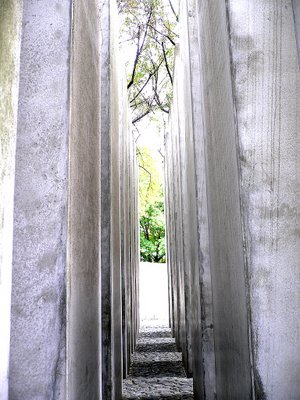Tuesday, October 24, 2006
Berlin, Germany, 15 Oct 2006: Jewish Museum
Soaring Planes And Searing Angles
  |
 Berlin's Jewish Museum, designed by Daniel Libeskind, is a dizzying construct of geometric forms and sharp edges. Adjoining walls, floors or ceilings seldom, if ever, meet at right angles. Rather the surfaces collide at angles off the perpendicular, conspiring to deceive the eye and the mind, inducing a curious state of mildly vertiginous disorientation, "This is level ground I am standing on, is it not?" Berlin's Jewish Museum, designed by Daniel Libeskind, is a dizzying construct of geometric forms and sharp edges. Adjoining walls, floors or ceilings seldom, if ever, meet at right angles. Rather the surfaces collide at angles off the perpendicular, conspiring to deceive the eye and the mind, inducing a curious state of mildly vertiginous disorientation, "This is level ground I am standing on, is it not?"Clad in titanium-zinc plates, the building's imposing exterior is razor-slashed with clinical ferocity. Open lancinating wounds, intersecting narrow slits of window, let in austere shafts of light. The effect is complete. One is immediately seized and held hostage, overwhelmed by the raw power, stark vision and unnerving strangeness of the architecture. |
  |
   |
Enter the museum via an underground passage from the baroque building next door. Three axes - Axis of Continuity, Axis of Exile, Axis of Death - lie at the foundation of the museum. Walk along the first and climb up a long flight of stairs - overhung by perilous slanting ceiling beams that appear about to tumble down any moment - to reach the permanent exhibit. The main building is skewered by a series of interconnecting void spaces that, desolate and impenetrable, are visible only through narrow glass windows cut into the wall at intervals.   |
   |
| The museum traces the two-thousand-year history of Jews in Germany, and documents their intellectual and cultural contributions. Racial hatred and discrimination, always beneath the surface, raised their ugly heads during the Nazi era. Jewish persecution began with racial laws in the 1930s. Geneology, abtrusely abused, marked Jews and half-Jews from the Aryan race. Miscegenation was verboten. The Holocaust erupted. In one of the void spaces, on the floor, thousands of metal discs resembling human faces - terror-stricken eyes wide open and mouth agape - look up at us: a deafening collective scream. In another, the faces are now gone; their imprints, a patina on the haunted silent ground. |
  |
| Tall wedged-shaped black granite walls stand at various locations in the exhibition area. Strap on the special headphones. Go very near to the wall to hear the commentary. Nose almost touching the wall, Jerusalem's Wailing Wall comes to mind. Exit the exhibition. Walk along the undergound Axis of Death. At the end, enter the Holocaust Tower, a few at a time. Total isolation, sensory deprivation and cold fear close in. The confined bare concrete space is totally dark, except for light piercing a tiny aperture near the ceiling: the light and its reflection form a shining V, a vestige of hope. |
   |
Finally, go along the Axis of Exile. Names of cities absorbing the Jewish Diaspora line the walls of the corridor. Push open the rhomboid door at the end and step gingerly - the ground slopes off the horizontal - into the Garden of Exile. Forty-nine concrete stelae, or pillars, stand erect in a grid on a small square set below ground level. On the tops of all except one, plants thrive on Berlin soil. On the last stele, soil from Jerusalem has been symbolically laid.  |
Labels: architecture, art, Berlin, Germany, history, museum, religious site

Licensed under Creative Commons Attribution-NonCommercial-NoDerivs 2.5 License

These are the 30 countries that I have ever set foot on. Airport stopovers don't count!
